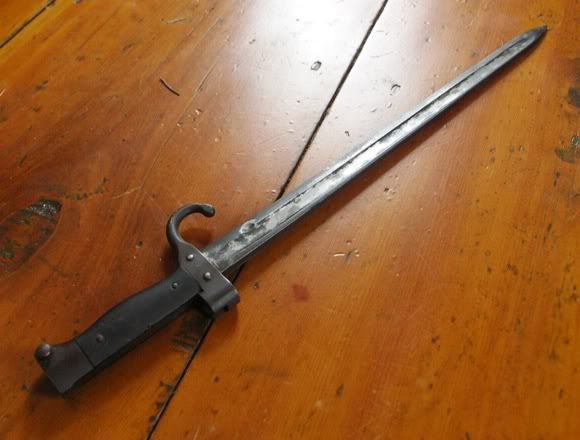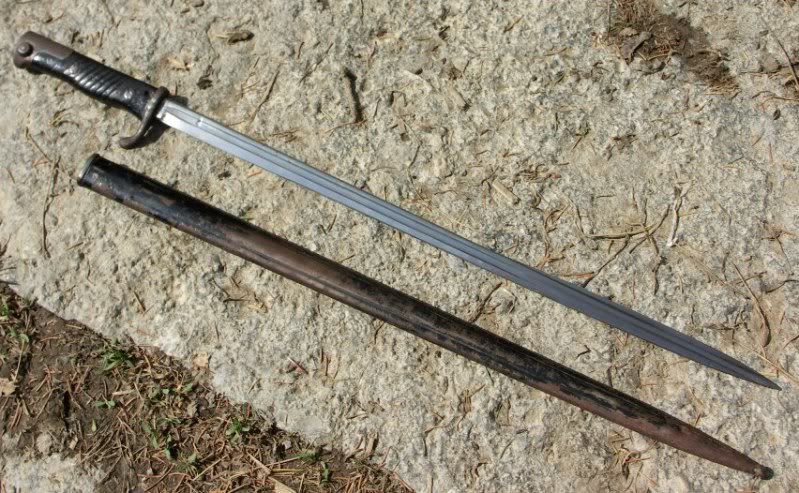
 |
|
|
|
|
#1 |
|
Member
Join Date: Dec 2004
Location: What is still UK
Posts: 5,807
|
I might be going round in circles with this idea. Look at these bayonet inspired knives/daggers. I recently received the Lebel bayonet as a match for the French West African bayonet inspired dagger. As you can see it is very closely observed. As is the item in this link-
http://www.vikingsword.com/vb/showth...light=Fabulous The question I ask is, any idea for the inspiration for the other bayonet dagger? I was looking at the British 1907 pattern bayonet before the removal of the quillon. But as these seem very closely observed I feel the 1907 blade is too long and the quillon not the right sort of curve. If a good possible match for inspiration is found it may help point to which area of Africa it could come from. |
|
|
|
|
#2 |
|
Member
Join Date: Mar 2009
Posts: 28
|
Actually, the ball-tipped crossguard on the second (white handled) blade more closely resembles the Turkish 1903 quillback bayonet, but I agree the longer one appears a native blade in the style of a "Rosalie" 1886 bayonet, or the Mle 92 Berthier Carbine Bayonet.
Really, when you talk about handcrafted blades, there's a lot of stylistic license involved, so it could be either, or an amalgam of both.  HA, look at me, the mass-produced-blades guy, finally being sorta-relevant and helpful! |
|
|
|
|
#3 |
|
Member
Join Date: Dec 2004
Location: What is still UK
Posts: 5,807
|
You have indeed been most helpful. I dare to call myself a sculptor
 and even allowing artistic licence. It is no surprise to me that the possible inspiration for this piece can seen. I have been able to nab these pictures of Turkish bayonets . There is a Belgian bayonet that is also a reason able match. I feel the Turkish bayonet has a definite chance especially After research. I have always felt this is West African work. The Ottoman army fought in North Africa, Libya, Sahara and into French west Africa. The Ottoman army was obviously in Egypt and the Sudan and I believe units in German East Africa. However I am not an expert and the item does not seen East African. I strongly suspect that it is from the regions around the borders of French West Africa and the Sahara of North Africa if that makes sense. and even allowing artistic licence. It is no surprise to me that the possible inspiration for this piece can seen. I have been able to nab these pictures of Turkish bayonets . There is a Belgian bayonet that is also a reason able match. I feel the Turkish bayonet has a definite chance especially After research. I have always felt this is West African work. The Ottoman army fought in North Africa, Libya, Sahara and into French west Africa. The Ottoman army was obviously in Egypt and the Sudan and I believe units in German East Africa. However I am not an expert and the item does not seen East African. I strongly suspect that it is from the regions around the borders of French West Africa and the Sahara of North Africa if that makes sense.
|
|
|
|
|
#4 |
|
Member
Join Date: Dec 2004
Location: What is still UK
Posts: 5,807
|
Niger and Chad would be French areas bordering south west Libya where the Turks were in action.
|
|
|
|
|
#5 |
|
Member
Join Date: Mar 2009
Posts: 28
|
Just to be fussy, the photos posted of Turk bayonets are of the 1935 reworked, ten-inch blades. The original Turkish 1903 blades were "quillback" like the German S98, and featured a stiffening rib like the shaft of a feather in addition to the fuller, with part of the blade edge protruding above that shaft like a dorsal fin on the latter third of the blade. That tip shape might, interpretively, tie in with the diamond-shaped tip on the dagger you posted.

|
|
|
|
|
#6 |
|
Member
Join Date: Dec 2004
Location: What is still UK
Posts: 5,807
|
Vaarok again very helpful. What interested me about this the pictures I posted is the shape of the bend in the forward sweeping quillon. I also like the idea of the white metal pommel. This link if it works, shows a shortened earlier version that appears to have had the quillon removed. Could be that there are many variants. The fin like blade could explain the shape of the African knife. It is all good fun learning about bayonets.
http://arms2armor.com/Bayonets/turk90a.htm This link is also worth looking at, note the curve to the quillon? http://www.collectiblefirearms.com/Bayonets.html#Turkey Last edited by Tim Simmons; 1st June 2010 at 01:06 PM. |
|
|
 |
|
|